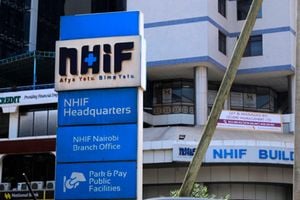
Mrs Winfred Kathure, a teacher at M.C.K. Kaaga Primary School in Meru County instructs Class Six pupils on January 3, 2019.
"Africa is the richest continent but has the poorest race. And that is a burning shame" Peter Tosh sang in his song I'll Not Give up Until Africa and Africans are Free.
Poverty in Africa has always baffled scholars. It is systematic and very perennial. Other parts of the world have now escaped it. At the start of this century, Asia used to be poor, particularly due to it's large populations.
Now the economic engine of the world revolves around the region.
An analysis of how countries escape poverty reveals that they need to tackle three issues to win. First, infrastructure, to ease doing business. Good roads, ports, railway, airports, dams and, now, the internet form this class.
The sector in poverty reduction is health. Human resource is the most important factor of production. A good health system boosts labour productivity and life expectancy. The third is education. One cannot build infrastructure without engineers and surveyors. Neither can you achieve good health unless you have trained medics. The pair is moulded via education.
Policies that prioritise health and infrastructure need sound government policy which are made possible through educated leaders. Africa is in competition with other parts of the world for progress within a capitalistic economic framework. This requires Africans to penetrate those other systems and study them for local adoption and replication. That only happens through education and immersion into our competitors mindset.
When Rome was the sole world superpower 2000 years ago, it set out to expand it's territory. And it expanded into almost the entire Europe, parts of Africa and Asia. But there is a part of Europe that proved impenetrable - Germany. The person who helped Germanic tribes to tackle the mighty Rome was Arminus. He had been captured as a child by Rome armies and trained to be an astute warrior.
Rome interests
As an adult, he was seconded to Germany to defend Rome interests. He defected back to his people and defeated Rome. Rome was so powerful and it's loss to a rag tag army of poorly-armed Germanic tribes led by Arminus was historical.
But Arminus was able to achieve this based on his deep understanding of Roman tactics and deep love of his country of origin despite having grown up as a Roman. The same logic applies in Africa and it's fate. Only people well educated in the ways of our competitors but who love Africa deeply can help us escape poverty.
But how do we craft our education policy to help us tackle poverty? Supporting day secondary schools is the easiest way towards this goal. Their fee is cheaper when compared with boarding institutitons. That means government entities that give secondary education bursaries (such as counties or National Government Constituency Development Fund) can give support to more students using fewer resources.
On average, annual fees paid by a single boarder can support four day school students. On average, 75 per cent of all Kenyan secondary school students are in day schools. For example, Murang’a has about 320 secondary schools with 260 of these day schools. A government concerned about equitable development in society therefore would direct resources to day schools to help more. A country keen on boosting primary to secondary schools transition rate must, therefore, see day school as being crucial to this goal.
Secondly, low income parents send their children to day schools in comparative terms for obvious reasons - lack of resources to afford the alternative. Third, day secondary students face greater barriers to education, thus creating a deeper moral reason for affirmative support. For instance, a typical day secondary school student walks one hour to and from an educational facility. He or she is expected to help in household chores unlike a counterpart in boarding school. Most Day schools lack vital facilities such as laboratories. Fourth, on account of their spread and local grassroots connections, well resourced day schools might spur local economy better.
Finally, three sociological forces contend towards influencing teenagers - family, teachers and peers. Day schools retain familiar influence, which psychologists have affirmed as being beneficial to children growth. Peer influence rises dramatically in boarding schools.
Better results
However, boarding schools definably churn better educational results when compared to day schools. For example, whereas boarding schools in Murang’a have only 25 per cent of total secondary schools students population, they produce 75 per cent of total students who transition to university. That explains their popularity with parents who deem day school education as "default mechanism".
But is there a possibility day school underperformance is correlated with government underinvestment? A crucial irony is that developed countries with the best education are largely day schooling. Are such results caused by day scholars spending less time studying comparatively? Or do day scholars' primary schools performance reflect on their final secondary school results?
Offcourse this is not a universal truth. One rural day school in Muranga sent 100 students to university in a single exam 2023. Probably lessons need to be learnt from such bright stars.
These are hard questions that have no simple answers. But they should not obscure the huge social gains Kenya would gain if it funds day schools appropriately, particularly increasing primary to high school transition rate.
Notwithstanding secondary school education being a national government role, many counties have laws that create legal pathways to intervene and assist in this sector. Better resourced counties go to great lengths to achieve this. Mandera County is currently educating all secondary school students for free irrespective of if they are in boarding or day schools.
Dr. Irungu Kangata is the Governor of Murang’a County. Email [email protected]









